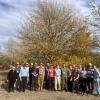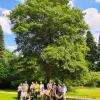Editor's Picks
Plant Focus
As I mentioned in the article “Why I Draw Oaks”, published in Oak News & Notes in November 2013, I started to draw Fagaceae species in 1994 for the simple reason that they are big trees and easy to distinguish by their fruits.

After receiving the gold medal at the RHS botanical art exhibition held in 2001, I published my first book, “Pictorial Encyclopedia of Oaks in Japan”, in 2004.
It was a ten-year effort to draw all Fagaceae species in Japan including some foreign species, Quercus robur, Q. rubra, and Q. palustris, planted in Japan.

When I traveled to the UK in 1999, I found that the leaf of Q. robur in England has a different shape to the ones I saw in Japan. I realized that the trees in their homeland are different from trees cultivated in Japan.

This is the main reason to draw species by traveling to their original locations. After the first book, I decided that to draw foreign species, I had to see them in their homeland.
There are only five genera of Fagaceae in Japan, out of a total of ten. So I tried to draw the remaining five genera in their original locations, selecting features like large acorns, small acorns, strange-shaped fruits, or rare species.
At first I had a hard time finding the locations for species, as the information on the internet ten years ago was not as developed as it is today. I had no idea where I could find them. I started to learn from available books and figured out what I could find outside of Japan.

My first exploration was in the U.S., stimulated by a TV program introducing an acorn woodpecker in California. After joining the IOS, many friendly members kindly assisted me, so it became a bit easier. The information that appeared on the internet also helped.

However, locating non-Quercus species, such as Lithocarpus, is not easy. I had to visit Borneo to search for them blindly, though it was fun sightseeing.

Meeting with Dr. Masatoshi Hara, who is knowledgeable about Fagaceae in Asia, has been very helpful. He is department chief at the Department of Plant Science at the Natural History Museum and Institute in Chiba, Japan, and specializes in Fagus.

It takes about two to three weeks to draw one species, typically the acorn on the twig, the acorn itself, and both sides of the leaf. The time window of fruiting is only three months, September to November, except for some species in tropical Asia which have fruits from February to April. This limited me to visiting only one or two countries and drawing four to six species in one year.

The editor of my first book advised me to publish the second book when I drew over 130 species, including species in Japan. The book, titled “Illustrated Flora of Fagaceae Trees of the World”, was published in November. This second book took another 16 years.

The book is written only in Japanese but includes scientific names and an index in English. Dr. Hara provides general information for each species in the book.
Because I may not travel and draw any more oaks for the moment due to COVID-19, I thought it is a good break for my work.


















